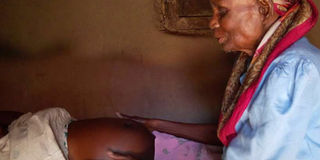How female genital cut makes a mess of childbirth

Birth attendants top choice for pregnant mums in rural Kisumu. A few years ago, towards the end of an absolutely crazy 24-hour shift in a fairly busy private maternity hospital, we received a patient in the wee hours of the morning who came to us in advanced labour. PHOTO| FILE| NATION MEDIA GROUP
A few years ago, towards the end of an absolutely crazy 24-hour shift in a fairly busy private maternity hospital, we received a patient in the wee hours of the morning who came to us in advanced labour.
She was a 20-year-old, first-time mum from a community that still practices the female genital cut.
As the midwife settled her into bed and took her though the admission process, I noted that she appeared a little too sombre for a new mum but could not quite put a finger on what was going on.
I was exhausted, running on a caffeine high and had a ton of laboratory results to review in preparation for the handing-over morning ward round, so I did not give it much thought at the time.
At about 5.30am, the midwife told me that she could not pick the baby’s heartbeat. This was not good at all. The woman was ready for my review, which was an emotional one for a young woman who was already in a lot of pain.
She had not been feeling any movement from her baby for two days but had failed to notify anyone as she did not quite understand the huge significance of this on the well-being of her unborn child. She was tearful when I explained that she seemed to have already lost her baby and we were not anticipating a joyful end to the labour.
As we were all grappling with the bad news, we got to the second round of things getting nasty. While examining her, I discovered she had undergone the most severe form of the female genital cut. The entire clitoris and labia minora were gone. The whole vulva area was one big shiny scar that had absolutely no elasticity. It was impossible to do a proper vaginal examination to assess how far her labour had progressed. I couldn’t help wondering how she had gotten pregnant to begin with.
In such cases, it is usually sensible to perform a Caesarian delivery to extract the baby and minimise further injury to the mum. In this case however, we had a dilemma.
Our patient hailed from a community that absolutely abhors Caesarian sections. It is looked upon as creating a disability in the woman and she will never be viewed as whole again. Hence getting consent for surgery was an uphill task. Secondly, she had lost her baby and the thought of nursing a surgery with nothing to show for it is a really tough call. Thirdly, she was already in advanced labour and would probably deliver before we got her on the operating table.
We decided on vaginal delivery. In view of her existing genital scarring, we had to give her bilateral episiotomy to widen the vagina for the baby to come out. She delivered a stillborn baby and we spent two hours suturing her episiotomy to restore the genitals to their initial state.
Most women dread episiotomies. The thick fleshy part between the vagina and the anus, made up of muscle, is called the perineum.
During delivery, the vaginal opening must widen to allow the baby to come through. This results in stretching of the perineum. Sometimes, the stretching is too much and the perineal muscles will tear, resulting in perineal tears. The doctor or midwife may opt to prevent the tearing by giving an episiotomy which involves cutting through this muscle to widen the birth canal then stitch it up thereafter.
For many years, the episiotomy was done routinely to most mothers. It was argued that a clean straight cut is easier to repair than tears that can be jagged and difficult to align back to normal. However, consistent research has now shown that episiotomies do not necessarily improve outcomes for either baby or mother and hence should not be routinely practised.
Instead, better perineal support during delivery is encouraged to minimise tears and hence minimise need for repairs.
However, in the case of mothers with genital scarring, mothers requiring extra help during a vaginal birth such as use of forceps or a vacuum to help extract the baby. For those with very big babies whose shoulders are stuck (shoulder dystocia), an episiotomy is unavoidable.
The episiotomy is given at the height of a contraction when the mother is experiencing intense pain and may not notice it happening.
Ideally, verbal consent should be sought from the mother before the episiotomy is given and a local anaesthetic agent injected into the site where the episiotomy will be given to ease the pain.
Most episiotomies heal uneventfully without the need for antibiotics and with minimal pain.
However, the mother must maintain strict hygiene for the duration of healing to minimise complications. Such may include infection of the wound with possible breakdown, requiring repeat repair; healing with scarring; pain during intercourse and misalignment of the genital tissues.
In the case of our patient, we were forced to make fairly big cuts on either side of vagina to avoid tearing scar tissue. The repair was difficult and exhausting for both the patient and the medical team. Subsequent deliveries will remain a challenge for her, with need to counsel her early and plan for the deliveries. She may have avoided a Caesarian section this time round but she still had deep wounds to nurse, both psychologically for her tragic loss and physically in her most private body parts.
As the female circumcision debate rages on, let us spare a thought for women like this who have no comprehension of what the results of the practice entail for the woman.



